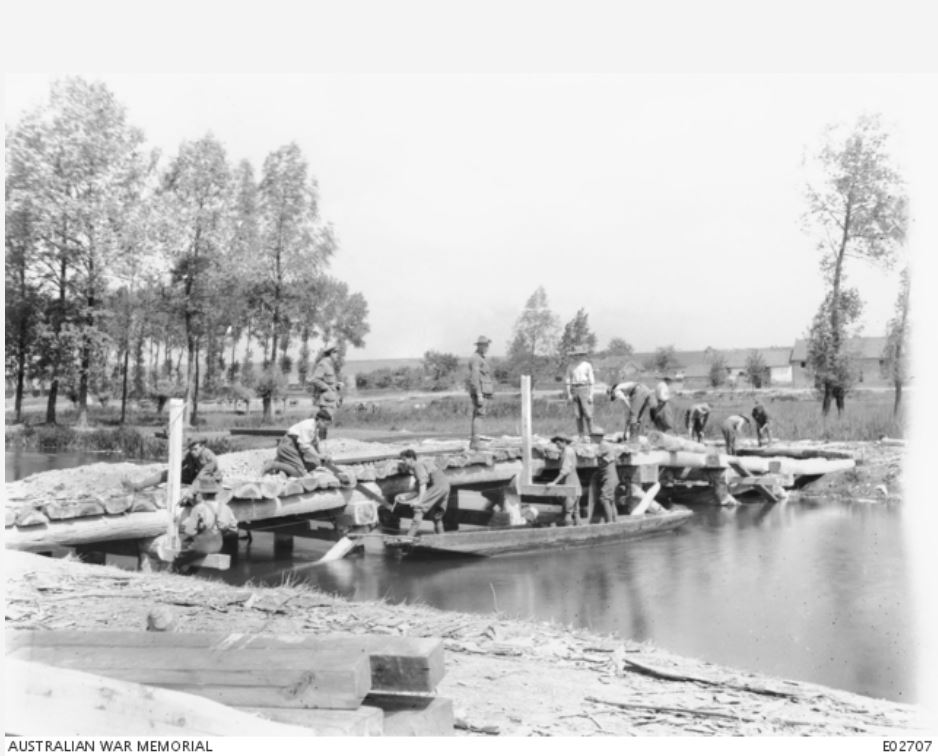10th Field Company - Engineers
From Our Contribution
 Shoulder patch | |
 A detachment of 10th Field Company building a bridge across the Somme Canal. AWM photo E02707 | |
Contents
Brief History
The 10th Field Company was attached to the 10th Brigade of the 3rd Division AIF, and was formed in early 1916 at the Domain camp in Melbourne before moving to Seymour for training. The Company personnel were finalised at the end of May, and the unit prepared to depart from Melbourne aboard HMAT A54 Runic on 20 Jun 1916.
Engineers, also known as sappers, were essential to the running of the war. Without them, other branches of the Allied Forces would have found it difficult to cross the muddy and shell-ravaged ground of the Western Front. Their responsibilities included constructing the lines of defence, temporary bridges, tunnels and trenches, observation posts, roads, railways, communication lines, buildings of all kinds, showers and bathing facilities, and other material and mechanical solutions to the problems associated with fighting in all theatres[1]
Only rudimentary initial training was undertaken before elements of the division began the embarkation process in May and June 1916 as they were moved to the United Kingdom, where the individual sub units concentrated for the first time, received arms and other equipment and began the task of undertaking further training, first at Brightlingsea from 19 Aug 1916, and then at Lark Hill, on Salisbury Plain from 14th October. In early November 1916 two divisional exercises were undertaken.
Finally, on 23 Nov 1916, the Company left Amesbury by train for Southampton from where they crossed the English Channel to Le Havre in France. After a night in a rest camp the unit embarked on a 47 hour, tedious journey to Bailleul. Soon after they were in the front line rebuilding and strengthening trenches and improving drainage in particular as the Allied front line in the Houplines sector was across very low lying ground, while the men were billeted in a large town where when off duty a coffee or something stronger was available. The winter of 1916/17 was very severe.
In April the company was in the Ploegsteert sector, on higher, better drained land building gun pits, repairing roads, building railways and approach routes to the front lines in preparation for the 3rd Division's attack as part of the attack on Messines Ridge in June which was to feature the detonation of 19 mines beneath the German front lines. As the attack progressed the Engineers were busy carrying materials, placing temporary bridges over the Douve River. On 9 Jun 1917 the Company was withdrawn for a brief rest at Nieppe before they supplied working parties for projects in the areas captured earlier.
A similar pattern marked their participation in the other battles that the 10th Brigade was engaged in. In the evening of 24th September the Company began a long route march in full kit from Beumont and Gallopin to Winnezeele to again find themselves working behind the front lines near Ypres, and in areas captured from the Germans during the various battles of the summer and autumn at Broodseinde and Passchendaele. A brief spell from the heavy work occurred between 23 Oct and 13 Nov 1917, followed by a return to line work in the Warneton section from 16 Nov 1917 until they were relieved on 8 Mar 1918. However, on 22 March they began an urgent move back from west of Poperinghe to the front, this time to Franvillers in the Somme Region. The Company was actively engaged in improving defences and preparing for any future return to offence until after 43 days of strenuous work helping to protect Amiens, they were relieved on 9 May 1918, but appear to have remained in the vicinity of Villers-Bretonneux. On 28 June they became responsible for guarding the Daours-Bussy-Querrier group of bridges over the Somme.
They were to continue to play a role in the Offensive that commenced on 8 Aug 1918, primarily on the north bank of the Somme, repairing bridges and maintaining roads etc. as the advance gathered pace until they reached Péronne where they were granted a break from 9th to 27th. Their next and last participation in a battel was hen, with Australian and US units they breached the Hindenburg Line. After this action they were withdrawn for the front, and
The Armistice came while all Australian units bar a few were in rest areas. It would take some time before all members of the until were repatriated to Australia, and generous leave was granted both locally and to London. Just before Christmas the unit relocated to Moyenville near Abbeville where they remained until the middle of March. The first draft of men for Australia left at this time, with the rest following progressively. Twenty seven men posted to this unit had died during their time away from Australia.
Unit Personnel
- † Harold Ross 9 Apr - 8 Jun 1917 (KIA
Battle Honours 10th Brigade
- Messines
- Broodeseinde
- Passchendaele
- Amiens
- Mont St Quentin
- Hindenburg Line
Individual Awards
- 1 x Distinguished Conduct Medal
- 4 x Military Cross
- 18 x Military Medal
- 1 x Bar to Military Medal
- 4 x Meritorious Service Medal
- 7 x Mentioned in Despatches
- 2 x French Croix de Guerre
Notes
Information has come from a variety of sources, but primarily a document held in the Victoria State Library entitled "History - 10th Field Coy, Engineers". Reference No LTP - 940.41294 H62T
- ↑ Alessandro Antonello 21 Jan 2009 https://www.awm.gov.au/articles/blog/australian-engineers-in-the-first-world-war sourced 9 Jan 2018